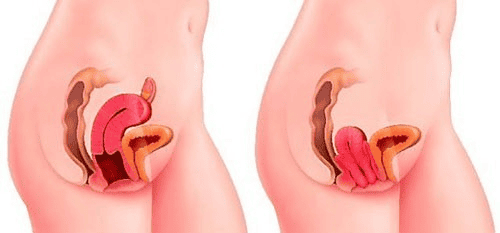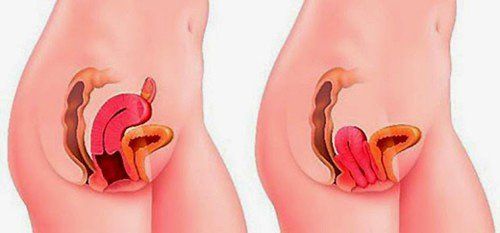This is an automatically translated article.
The article is professionally consulted by Specialist Doctor I Le Thi Phuong - Department of Obstetrics and Gynecology - Vinmec Ha Long International Hospital.
Pelvic floor prolapse is a disease that brings many concerns to women, especially postpartum mothers. If not detected in time and have the right treatment, uterine prolapse will cause adverse complications.
1. Is uterine prolapse dangerous?
Uterine prolapse can be divided into 3 levels as follows:
Level 1: the mildest, the uterus has prolapsed but is still in the vaginal canal. Grade 2: The uterus has retracted outside the vaginal opening and can be seen with heavy work or with a lot of activity. Level 3: the entire uterus is lowered and out of the vagina, visible to the naked eye image of a pink uterus, the size of a chicken egg. This is a dangerous case of uterine prolapse because it is likely to become infected and must be removed because the uterus is not able to contract on its own. There are many women who are worried and insecure about whether cervical prolapse is dangerous when suffering from this disease. However, although uterine prolapse is not a problem that threatens and endangers a woman's life directly, it has a great impact on daily activities and sexual activities. As a rule, if the disease is detected and treated promptly, when the uterus is prolapsed at a mild level, the patient will not be too affected.

2. Common complications of uterine prolapse
Women with uterine prolapse should be alert to some dangerous complications of the disease such as:
2.1. Vaginal ulceration This complication will occur when the patient has the most severe disease – level 3. At this time, the uterus is prolapsed, pulling a part of the vaginal lining and protruding outside the vagina, causing rubbing against clothing. This can cause vaginal sores and lead to a pretty serious infection.
2.2. Prolapse of other pelvic organs: Genital Prolapse The retraction of the pelvic organs (uterus, bladder, rectum...) through the vagina is collectively known as genital prolapse. When the disease becomes severe, the patient may experience prolapse of the pelvic organs, including the rectum and bladder. Or all of the above combined, the uterus loses its connection to nearby organs and will slip out of the vulva, even with very little pressure, dragging the bladder and rectum.
Anterior vaginal prolapse with bladder or bladder prolapse Posterior vaginal wall prolapse with rectal pouch or rectal prolapse Enlarged cervix with low uterus Prolapse of other pelvic organs may causes a lot of difficulties in the patient's excretion, worse, increases the risk of urinary tract infections. Bladder prolapse into the anterior part of the vagina can lead to difficulty urinating and increase the risk of urinary tract infections. Weakness of the connective tissue located in the rectum can cause rectal prolapse, which leads to difficult bowel movements.
3. Prevention of uterine prolapse and disease progression

Uterine prolapse is a common disease, but it is easy to prevent the disease as well as limit the progression of the disease.
3.1. Reasonable postpartum rest One of the most common causes of the disease is damage to the muscles and ligaments that support the uterus, so to prevent uterine prolapse, women after giving birth It is necessary to follow the following notes:
Absolutely do not get out of bed to exercise vigorously or work too hard right after giving birth, to ensure your health after giving birth. After recovering, do not lie in bed too much, but should exercise gently. Prevent constipation after giving birth. If you have difficulty in defecation, you should not push hard, have a high-fiber diet, drink lots of water or eat foods that help laxatives. Pay attention to keep warm for pregnant women, prevent colds and coughs. 3.2. Exercise appropriate exercises For postpartum women, exercises to strengthen the contractions of the hip and anal muscles are very necessary, helping to improve the mother's health and prevent uterine prolapse very effectively. fruit. Kegel exercises are a popular healing exercise and bring many benefits to women:
Kegel exercises can be done while sitting on a chair or lying on the floor: relax the muscles of the buttocks and abdomen, stretch Straight back, arms parallel to the knees at the same time. Start the exercise by tightening your pelvic floor muscles and lifting your hips up for 2 to 5 seconds, then relax for 10 seconds so the muscles can relax. Continue then repeat the tightening - releasing 10 times. You can increase the number of seconds after getting used to the exercise.
Please dial HOTLINE for more information or register for an appointment HERE. Download MyVinmec app to make appointments faster and to manage your bookings easily.














